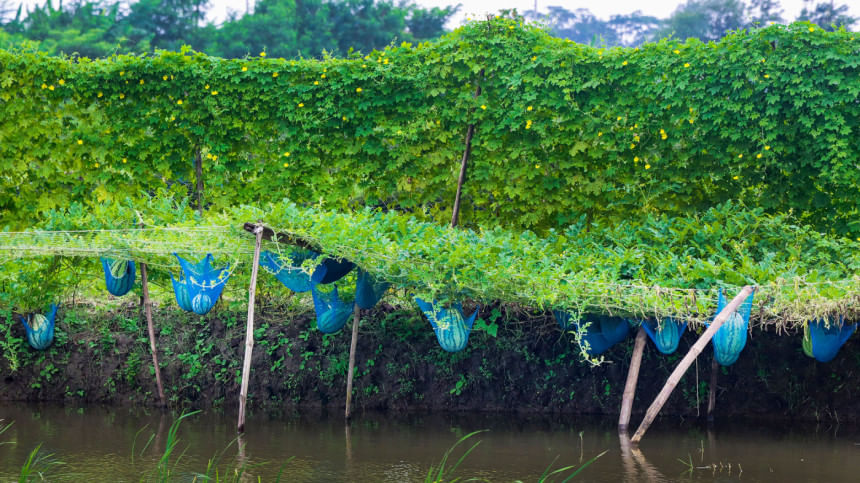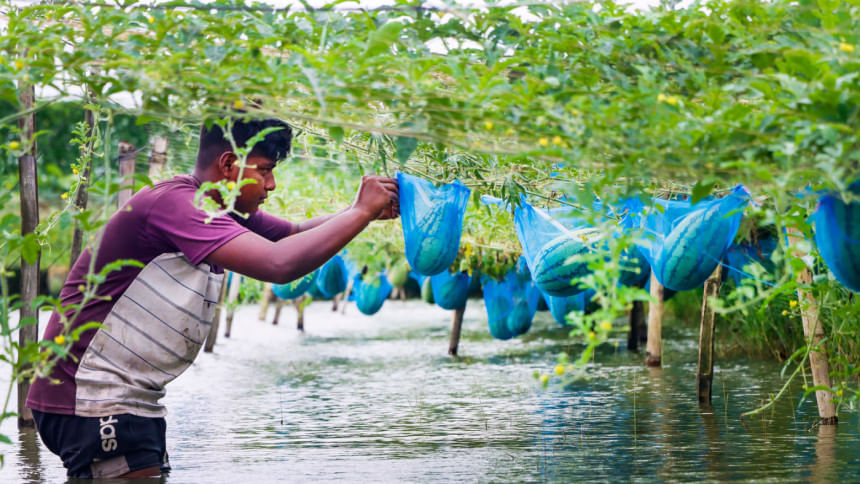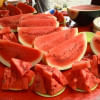Sweet harvest on saline shores

On the saline fringes of Bangladesh's southwest coast, where seawater intrusion and freshwater scarcity have long dictated the fate of crops, a quiet agricultural revolution is ripening.
Including Dacope, Batiaghata, Dumuria, Koyra and Terokhada upazilas in Khulna district -- better known for their fish enclosures (gher) and shrimp farming -- the region has emerged as the most prolific producer of off-season watermelon.
While summer watermelon cultivation in this coastal belt is fraught with challenges, the monsoon season is telling a different story. Farmers are now using the elevated banks of their fish ponds to grow the fruit during the rainy months, free from the irrigation woes and salinity concerns that cripple their summer harvests.
Off-season watermelon offers high yields, lower costs, chemical-free production and sweet profits.

In the summer, farmers in coastal Khulna face the harshest obstacle of all: water. Groundwater and surface water sources are often laden with salt, unsuitable for irrigating watermelon. Many resort to expensive alternative irrigation systems, pushing production costs for one bigha (about 0.33 acre) up to Tk 30,000–35,000. For some, the returns do not cover expenses, leading to losses.
During the monsoon, the story changes. Rainwater replenishes the gher, diluting salinity and providing abundant, low-cost irrigation. It needs Tk 7,000 to 8,000 for a bigha. The raised pond banks -- typically 3 to 4 feet high -- keep the plants safe from waterlogging even during heavy downpours.
This innovation is not just a small experiment. According to agricultural officials, more than 6,000 farmers across Khulna's nine upazilas are engaged in off-season watermelon farming this year, with expected combined earnings exceeding Tk 150 crore.
One such farmer is Amrito Mondal, a resident of Tiladanga village in Dacope's Tiladanga union and a first-year degree student at Chalna KC College. Inspired by his father, Asim Mondal, Amrito ventured into off-season watermelon cultivation last year. Using the banks of his fish enclosure, he invested Tk 10,000 to cultivate the fruit on 1.5 bighas of land. The gamble paid off: he sold his harvest for Tk 60,000.
"This year, I've planted watermelon on the same gher bank," Amrito said. "I have already sold 426kg at Tk 52 per kg and expect to sell another 800–900kg."
Even this year's heavy rains failed to deter him. "The excess rain caused a bit of trouble, but we managed," he said.

In Amrito's village and nearby areas, 35 to 40 other farmers have also embraced the practice. Shyamal Roy is one of them.
"I've been growing off-season watermelon for several years now, and it's definitely profitable," Shyamal said. Last year, his three bighas of gher bank brought him nearly Tk 2 lakh in profit. "This year, I planted about 1,000 watermelon plants on the same land. Despite some losses from rain, I expect a good profit. In the next few days, I will take 1,200–1,250 kg of watermelon to Dumuria's wholesale market."
According to the Department of Agricultural Extension, in at least 40 villages, over 350 farmers have cultivated off-season watermelon this year on 16 hectares of gher banks in Dacope alone.
Agriculture Officer Md Shafiqul Islam said yields are expected to reach 28–30 tonnes per hectare. "That means 480 tonnes of watermelon will be produced in this upazila alone, with a market value of Tk 2.3 crore," he said.
In the 2021–22 fiscal year, off-season watermelon was cultivated on 315 hectares of land, producing 8,820 tonnes. The following year, 2022–23, the cultivated area increased to 374 hectares with a production of 10,472 tonnes. In 2023–24, cultivation expanded significantly to 400 hectares, with production standing at 13,280 tonnes.
In 2024–25, the cultivated area was 929 hectares, and production surged to 29,728 tonnes, significantly higher than in previous years. For the upcoming 2025–26 fiscal year, the target has been set at 920 hectares of cultivation with an expected yield of 29,440 tonnes.
Md Nazrul Islam, deputy director of the Khulna Agricultural Extension Department, said off-season watermelon is more than a financial lifeline. "It is a companion crop that fits neatly into the agricultural cycle without disrupting other farming activities. Farmers grow it alongside fish cultivation, turning what was once idle land into a productive asset."

 For all latest news, follow The Daily Star's Google News channel.
For all latest news, follow The Daily Star's Google News channel. 







Comments